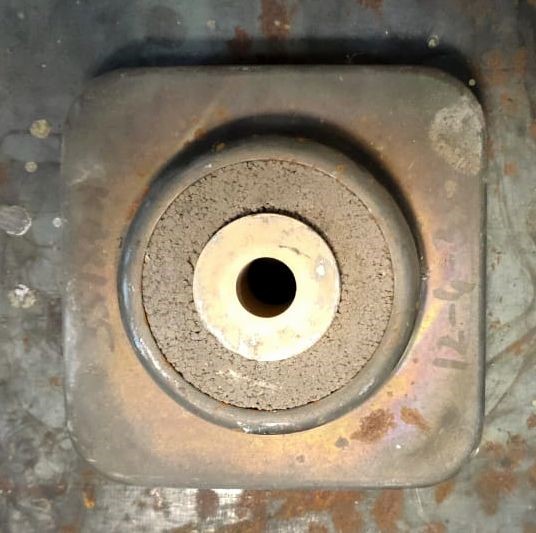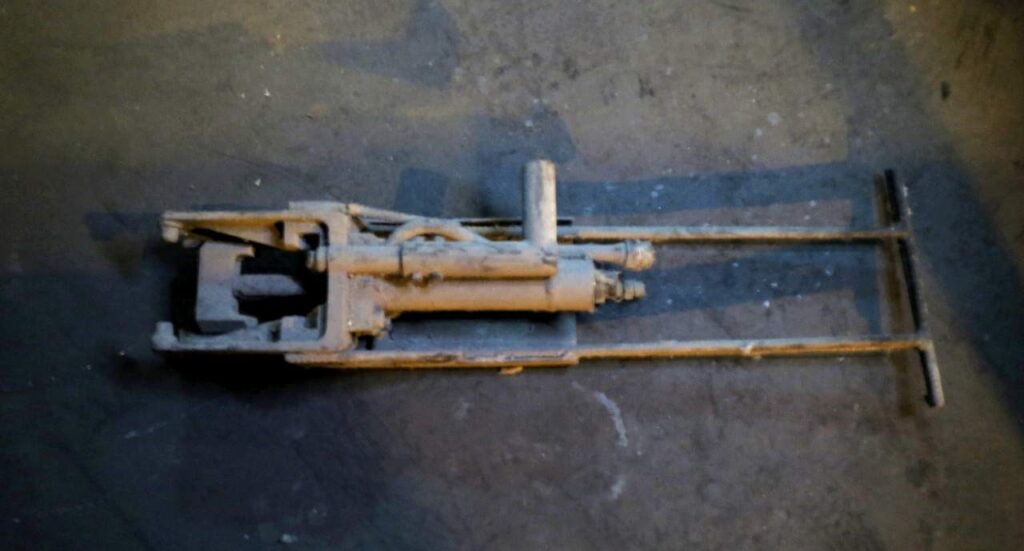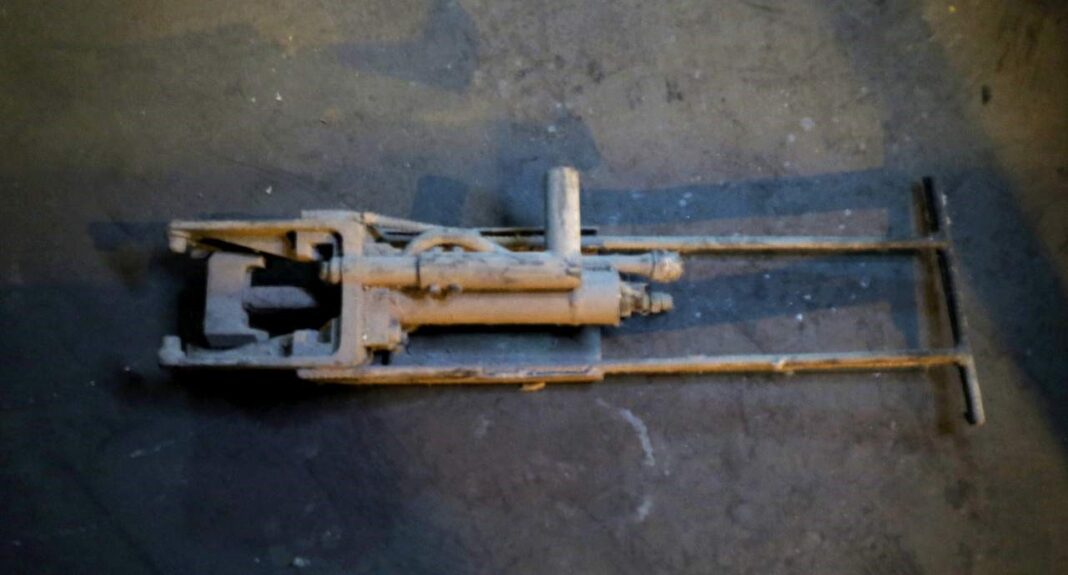The flow control has a substantial effect on the quality of steel. The flow control from the tundish is brought about by the means of slide gate, stopper rod or calibrated nozzles. The recently developed calibrated nozzle and the tube changers have been found successful in improving the tundish performance.
Before the invention of nozzle changer, the life of the submerged entry nozzle limited the life of the tundish. Nozzle changing has been found useful in increasing the casting duration leading to proper utilization of the tundish life, improving productivity and reducing energy loss due to preheating.
Calibrated Nozzle changer
Previously standard calibrated nozzles were developed which were reworked and assembled inside the steel plant. The mechanism has to support and drive the nozzle sliding carrier against the calibrated nozzle. The upper nozzle had to be perfectly positioned (horizontally and vertically). Every casting port on each tundish has to be equipped with a mechanism. This requires numerous mechanisms and extensive installation work. Thus later on designers designed a new generation system having the calibrated nozzle change concept. Tundish casting duration got enhanced by the use of calibrated nozzle hot exchange.

The goals of CNC goals was to have user-friendly equipment, only one cylinder operation for all strands, free top plate for deskulling, reduced tundish costs by cutting down manpower, refractory, and energy, increase caster yield, achieve higher casting time and tundish sequence length.
CNC Design:
The upper nozzle plate is designed to avoid exposure to steel splashes. The truncated upper plate has a 45 degree angled edges to provide instant surface contact with the standby exchangeable plate for smooth loading.
Light gate-The approximate weight being 20kg and not more than 15 pieces including bolts are used. The mechanism comprises only two frames that are articulated known as the ”Nutcracker design”. They include four sets of coil springs and rockers that press together two identical square plates. The plates are offset to each other by 45 degrees which provide an instant interface for the stand-by nozzle exchange plate and therefore ensures a smooth movement into the casting position. The cassette is attached to the tundish mounting plate by means of two T-bolts.
Plate loader-The CNC uses a detachable plate loader (9 kg mechanism) with a hydraulic cylinder to push the old nozzle plate out and the new nozzle or blank plate into position in less than 0.2 seconds. Its quick attachment or release feature allows the operator to position the new refractory plate well away from the casting strand, a much safer operation than with the previous systems.

The design makes it feasible to operate the nozzle exchange function with a portable hydraulic unit. Once a nozzle exchange is required the plate loader is attached to the CNC gate at the desired strand and after the nozzle is changed the plate loader is removed again.
Well block-free lining
The system does not require a well block instead a ramming material is used around a mandrel to shape the tundish well after the CNC is attached to the tundish . Therefore, the tundish lining operator does not have to take care to precisely centralize the tap hole. This center position is fixed by the mechanism and not by the lining.
Free top plate for deskulling
Due to its nut cracker articulated design, the CNC is disassembled in two parts ( Heatshield and two T- bolts released) soon after the sequence end. The blank plate falls to the ground, whilst the upper plate remains attached to the tundish lining by means of the solid metal remaining in its bore. This plate together with the rammed well remains attached to the skull when deskulling. This means that the deskulling operation is easier than before because there is no remaining attachment of the casting bore to the nozzle changer. Oxygen cleaning is also not required. As there is no mechanism on the tundish bottom (only mounting plates), the tundish can be transported without special care. There is no risk to damage any mechanism equipment when the tundish is deskulled and layed on the bumpy and dirty ground of the steel shop.
CNC cassette Refitting
The two articulated frames of the CNC gate reassembled together with the two plates in about one minute. There is no spring adjustment. During the plate setting, the springs are compressed by a lever system. The job is generally achieved by one tundish lining operator and no mechanic is required as virtually no maintenance is necessary.
Tundish application
The mounting plate is attached to the nut plate located inside the tundish shell by means of 3M16 screws. Therefore, it is only necessary to drill 3 holes through the tundish bottom shell and to enlarge the tap hole to 340 mm diameter. It is possible to adjust the horizontal position of the gate by means of 3 adjusting screws. This allows a perfect casting stream in the center of the billet mold. The operator can choose from a variety of nozzle dia ranging from 15 mm to 22 mm depending on the speed requirement of the caster. However, the speed can also be regulated to some extent by varying the tundish metal level height.
Advantages: CNC facilitates easy nozzle change over to a variety of diameters and speed regulation according to the convenience of the operator. The restranding becomes a easy and viable option. The process also offers enhanced reliability due to the safe and easy operation due to fast nozzle exchange in less than 0.2 seconds and immediate emergency cut off by firing the blank plate.
Easy tundish preparation with easy mounting, offline cassette preparation without tundish tilting, low weight cassette, gate fixed to the tundish by T bolts and removed by opening into two parts and upper nozzle gets removed along with steel skull.
Tube changer
The nozzle exchange becomes a necessity when the SEN gets eroded/damaged, or clogging has taken place due to alumina deposition impeding the fluid flow pattern in the mold. Present development in the tube changer technologies has enabled a fast, safe nozzle exchange without considerably lowering the casting speed and that too without the raising the tundish from the casting position.
The invention of the tube changer has offered extended casting duration which leads to increased productivity or yield, thereby reducing the operational cost. The prime yield can improve by 0.85% through the elimination of the 1.5m crop typically required to remove the scar on a flying tundish change slab, and the reduction in the number of tundish skulls. Slab downgrades also can be reduced as a result of being able to maintain casting speeds above the minimum acceptable for the grade being cast. The tundish consumption per year can be reduced by 60% and overall tundish refractory costs can be reduced by almost 50% The process eliminates flying tundish breakouts and strand closures due to submerged nozzle breakage/ clogging due to inclusions deposition.
The typical arrangement consists of a firing actuator which is kept in its ready- to-push position. When the submerged nozzle is worn out, the actuator is moved in its parking position, the blank plate is removed and a new preheated mono-block submerged nozzle is loaded in the mechanism and slowly immersed in the molten steel. This is achieved without tundish lift. The stopper is closed and the nozzle is moved to its casting position by means of the hydraulic actuator and in the meantime, the new nozzle pushes out the worn nozzle outside of the mechanism. The stopper is opened again and the used nozzle is removed out of the mold. After completion of the exchange, the blank plate is again loaded in the mechanism and the actuator is moved to its ready-to-push position.
The first tube changer known as the TCD 90 was used at British Steel Teesside Works. Basically, the Vesuvius portfolio of tube changer consisted of two types of system: push bar- TCD system and the SEM design.
Old generation Tube changer: The typical arrangement of TCD consists of a pneumatic actuator with a push-bar and side-mounted cylinder which operates without the need for any hydraulic supply. The mechanism has provisions for direct attachment of the pneumatic cylinder.
The SEM has two hydraulic alternatives. The manual swing design comprises of swing arm mounted hydraulic direct-acting drive (firing cylinder), which incorporates a pivot mounted direct acting cylinder with the self-locking device. The hydraulic cylinder, which is easy to detach, remains on the tundish car. In the power swing alternative, the swing movement is brought about by means of a second hydraulic cylinder commonly known as swing cylinder. The firing cylinder design is also the same. Both the cylinders are permanently mounted to the mechanism.
Initially, the TCD version used a real top plate with an inner nozzle and a hard plate monotube. A real plate, which is relatively large compared to the monobloc inner plate, is pressed by means of a conventional press(isostatically, multi-directional and pressed with the inner nozzle) and the pressure was applied by means of leaf springs. The shape of the well blocks was the same as that of the conventional ones. Direct argon injection takes place by means of piping directly connected to the refractory.
Two monobloc isostatically pressed refractory parts were used for the SEM version. The argon injection was achieved through the gate attachment to the mounting plate. The monobloc inner nozzle placed on a clamp ring with the help of small coil springs compressed by the mounting plate. The monobloc submerged nozzle is pushed upwards by means of small coil springs and rockers. The well block was rammed to avoid the use of another refractory part and to simplify the installation.
Note: To reduce turbulence in the mold and bending force on the casting tube it is not recommended to perform the tube exchange in less than 1.5 seconds.
It is recommended to close the stopper during the exchange to avoid the formation of steel fins between the plates and hence more build-up and air infiltration after the following tube exchange. The effectiveness of air sealing and the performance of the tube changer depends on the quality and the design of the refractory components.
Manual nozzle exchange
The manual nozzle exchange takes place by lifting the preheated SEN with the help of the holder and the worn-out or clogged nozzle is replaced by the new one. The monobloc stopper is closed prior to this operation. The speed is kept at a minimum of either 0.2 m/min or sometimes even zero.
Nozzle changing in case of slide gate arrangement takes place in the same manner where the speed is reduced to 0.2 m/min automatically and the strand operates in cast interruption mode where the slide gate throttles in an almost closed position. However, the nozzle change over should take place in less than three minutes.



